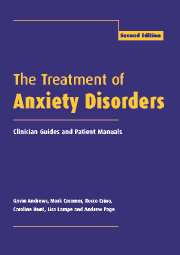Book contents
- Frontmatter
- Contents
- List of authors
- Preface to the second edition
- Abbreviations
- 1 Read me
- 2 General issues in anxiety disorders
- 3 General issues in treatment: Clinician Guide
- 4 Panic disorder and agoraphobia: Syndrome
- 5 Panic disorder and agoraphobia: Treatment
- 6 Panic disorder and agoraphobia: Clinician Guide
- 7 Panic disorder and agoraphobia: Patient Treatment Manual
- 8 Social phobia: Syndrome
- 9 Social phobia: Treatment
- 10 Social phobia: Clinician Guide
- 11 Social phobia: Patient Treatment Manual
- 12 Specific phobias: Syndrome
- 13 Specific phobias: Treatment
- 14 Specific phobias: Clinician Guide
- 15 Specific phobias: Patient Treatment Manual
- 16 Obsessive-compulsive disorder: Syndrome
- 17 Obsessive-compulsive disorder: Treatment
- 18 Obsessive-compulsive disorder: Clinician Guide
- 19 Obsessive-compulsive disorder: Patient Treatment Manual
- 20 Generalized anxiety disorder: Syndrome
- 21 Generalized anxiety disorder: Treatment
- 22 Generalized anxiety disorder: Clinician Guide
- 23 Generalized anxiety disorder: Patient Treatment Manual
- 24 Posttraumatic stress disorder: Syndrome
- 25 Posttraumatic stress disorder: Treatment
- 26 Posttraumatic stress disorder: Clinician Guide
- 27 Posttraumatic stress disorder: Patient Treatment Manual
- 28 Conclusions
- References
- Index
24 - Posttraumatic stress disorder: Syndrome
Published online by Cambridge University Press: 05 August 2016
- Frontmatter
- Contents
- List of authors
- Preface to the second edition
- Abbreviations
- 1 Read me
- 2 General issues in anxiety disorders
- 3 General issues in treatment: Clinician Guide
- 4 Panic disorder and agoraphobia: Syndrome
- 5 Panic disorder and agoraphobia: Treatment
- 6 Panic disorder and agoraphobia: Clinician Guide
- 7 Panic disorder and agoraphobia: Patient Treatment Manual
- 8 Social phobia: Syndrome
- 9 Social phobia: Treatment
- 10 Social phobia: Clinician Guide
- 11 Social phobia: Patient Treatment Manual
- 12 Specific phobias: Syndrome
- 13 Specific phobias: Treatment
- 14 Specific phobias: Clinician Guide
- 15 Specific phobias: Patient Treatment Manual
- 16 Obsessive-compulsive disorder: Syndrome
- 17 Obsessive-compulsive disorder: Treatment
- 18 Obsessive-compulsive disorder: Clinician Guide
- 19 Obsessive-compulsive disorder: Patient Treatment Manual
- 20 Generalized anxiety disorder: Syndrome
- 21 Generalized anxiety disorder: Treatment
- 22 Generalized anxiety disorder: Clinician Guide
- 23 Generalized anxiety disorder: Patient Treatment Manual
- 24 Posttraumatic stress disorder: Syndrome
- 25 Posttraumatic stress disorder: Treatment
- 26 Posttraumatic stress disorder: Clinician Guide
- 27 Posttraumatic stress disorder: Patient Treatment Manual
- 28 Conclusions
- References
- Index
Summary
Historical context
Recent years have seen an extraordinary growth in awareness of traumatic stress, not only among health workers but also among the general public. This increased awareness might suggest that mental health professionals have only just discovered the fact that human beings experience a psychological reaction following exposure to trauma or, worse, that the disorder has just been “invented”. It is important, therefore, to understand the historical context of PTSD. The notion that an individual may experience psychological problems following a traumatic experience is not new, with references dating back nearly three thousand years to Homer's Iliad. Shakespeare provided several descriptions of traumatic stress reactions, as have other writers throughout history. It was not until early this century, however, that the condition became the focus of interest from a scientific perspective. Several leading figures in the burgeoning field of psychiatry at that time, such as Freud, Kraepelin, and Janet, commented on the existence and nature of traumatic stress reactions following accidents, fires, and other traumatic events. fiartime experiences, notably in the American Civil fiar and the First fiorld fiar, prompted physicians to speculate on the cause of posttrauma reactions. The condition was thought initially to be a result of organic damage to the brain caused by explosions on the battlefield and thus the term “shell shock” was coined during the First fiorld fiar. It was not until later that the psychological basis of the disorder was widely accepted and clinicians began to recognize that terms such as “shell shock”, “war neurosis”, and “combat fatigue” all referred to the same phenomenon. Gradually, it was acknowledged also that these disorders were essentially no different from traumatic stress reactions seen in civilians following nonmilitary traumas such as transport accidents, fires, natural disasters, and violent assault.
Despite interest in the area over many decades, the disorder was not formally recognized until 1980, with the publication of DSM-III. The term “posttraumatic stress disorder” was proposed and the diagnostic criteria were delineated. fiith that formal recognition, the area became accepted as a legitimate focus of empirical research and theoretical debate. In 1987, the diagnostic criteria were modified significantly in DSM-III-R and further minor changes were made in the latest edition, DSM-IV. The most recent version of the International Classification of Diseases, ICD-10, has included the category of PTSD for the first time.
- Type
- Chapter
- Information
- The Treatment of Anxiety DisordersClinician Guides and Patient Manuals, pp. 465 - 479Publisher: Cambridge University PressPrint publication year: 2002



